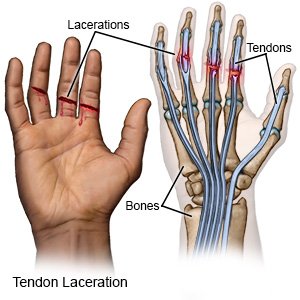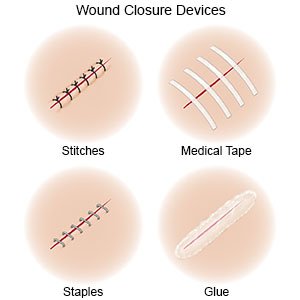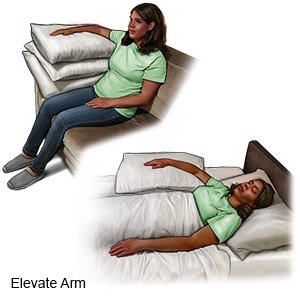Finger Laceration
Medically reviewed by Drugs.com. Last updated on Sep 23, 2025.
AMBULATORY CARE:
A finger laceration
is an injury to your skin and the soft tissue under it. Your blood vessels, bones, joints, tendons, or nerves may also be injured.
 |
Signs and symptoms:
Your symptoms may depend on whether nerves, tendons, or deeper tissues were injured. You may have any of the following:
- A cut, tear, or gash in your finger
- Bleeding, swelling, or pain
- Numbness or tingling in your finger
- Trouble moving your finger
Seek care immediately if:
- Your wound reopens.
- You have heavy bleeding or bleeding that does not stop after 10 minutes of holding firm, direct pressure over the wound.
- Your finger is pale and cold.
- You have new tingling, weakness, or numbness near the wound.
- You have trouble moving your finger.
- You have red streaks on your skin coming from your wound.
Call your doctor or hand specialist if:
- You have a fever or chills.
- You have pain in your finger or hand that gets worse, even after treatment.
- Your wound is red, warm, or swollen.
- You have white or yellow drainage from the wound that smells bad.
- You have questions or concerns about your condition or care.
Treatment
depends on how large and deep the laceration is. It also depends on whether you have damage to deeper tissues. You may need any of the following:
- Pressure may be applied to stop bleeding.
- Wound cleaning may help remove dirt or debris. This will decrease the risk for infection. Your healthcare provider may need to look inside your wound for foreign objects or damage to deeper tissues. Your provider may give you medicine to numb the area and decrease pain. You may also be given medicine to help you relax.
- Wound closure with stitches, staples, tissue glue, or medical strips may be needed. These may help the wound heal and prevent infection. Your provider may give you medicine to numb the area and decrease pain. You may also be given medicine to help you relax. Stitches may decrease the amount of scarring you have. Some lacerations may heal better without stitches.

- Medicine may be given to treat pain or decrease your risk for infection. You may also be given a tetanus shot. Your provider will decide if you need a tetanus shot. Wounds at high risk for tetanus infection include wounds with dirt or saliva in them. You should get a tetanus shot within 72 hours of getting a laceration or wound. Tell your provider if you have had the tetanus vaccine or a booster within the last 5 years.
- Surgery may be needed to clean your wound and remove foreign objects. Surgery may also be needed to repair injuries to tendons, nerves, or bones.
Care for your wound:
- Keep your wound dry for the first 24 to 48 hours, or as directed. Do not soak your hand in water. When your provider says you can, carefully wash around the wound with soap and water. Let soap and water run over your wound. Gently pat the area dry or allow it to air dry. Do not swim or sit in a hot tub until your provider says it is okay.
- Change your bandages when they get wet, dirty, or after washing. Apply new, clean bandages as directed. Do not apply elastic bandages or tape too tightly. Do not put powders or lotions on your wound.
- Apply antibiotic ointment as directed. Your provider may give you antibiotic ointment to put over your wound if you have stitches. If you have medical strips over your wound, let them dry up and fall off on their own. If they do not fall off within 14 days, gently remove them. If you have glue over your wound, do not remove or pick at it. If your glue comes off, do not replace it with glue that you have at home.
- Check your wound every day for signs of infection. Signs may include swelling, warmth, redness, or pus.
Self-care:
- Apply ice to the wound for 15 to 20 minutes every hour or as directed. Use an ice pack, or put crushed ice in a plastic bag. Cover the bag with a towel before you apply it to your skin. Ice helps decrease swelling and pain.
- Elevate your hand above the level of your heart as often as you can. This will help decrease swelling and pain. Prop your hand on pillows or blankets to keep it elevated comfortably.

- Use a splint as directed. A splint will decrease movement and stress on your wound. The splint may help your wound heal faster. Ask your healthcare provider how to apply and remove a splint.
- Decrease wound scarring. You may need to apply ointments to your wound or the area around it. Ask which ointment to buy and how often to use it. You may need to wait until your wound is healed. After your wound is healed, use sunscreen over the area when you are out in the sun. The skin around your wound may turn a different color if it is exposed to direct sunlight. You should do this for at least 6 months to 1 year after your injury.
Follow up with your doctor or hand specialist:
You will need to return in 3 to 14 days if you have stitches or staples so they can be removed. You may be referred to a specialist for more tests or treatment. Write down your questions so you remember to ask them during your visits.
© Copyright Merative 2025 Information is for End User's use only and may not be sold, redistributed or otherwise used for commercial purposes.
The above information is an educational aid only. It is not intended as medical advice for individual conditions or treatments. Talk to your doctor, nurse or pharmacist before following any medical regimen to see if it is safe and effective for you.
Learn more about Finger Laceration
Care guides
Further information
Always consult your healthcare provider to ensure the information displayed on this page applies to your personal circumstances.
